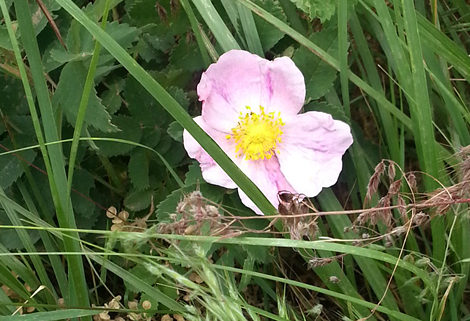Everything’s Rosy!
|
Here in Colorado’s foothills and mountain slopes, our future is rosy. So is our present, and for some time, so has been our past. We are fortunate in that almost everywhere we look, we see roses. Although June is the traditional month for traditional roses, the native roses we enjoy here often appear in May. Many of them, however, masquerade under other names, some even under disguises so complete most of us never suspect their true identities. There are roses hiding, literally, in almost every one of the flowering shrubs we seek out for their color and beauty each spring. Roses have long been the domesticated friends of humans, serving in a variety of capacities. Flower and fruit provide pleasure and food, fragrance and sustenance. Among familiar tame roses, we find apples, pears, peaches, apricots, cherries, strawberries, blackberries, raspberries: It’s hard to make a fruit pie without involving one or another of Rose’s cousins. If these fruits seem too diverse to be related, it’s because the Rose Family, with 3,000 members worldwide and 69 species here, is large and a bit unwieldy. Botanists often divide it into three separate subfamilies: The apple subfamily, with its multi-seeded fruits, includes pears, quinces, and hawthorns; the peach subfamily includes the “stone” fruits, cherries, plums, and apricots; and the rose subfamily is a catch-all for the rest—strawberries, true roses, potentillas, raspberries, and so on. A close look at the flower reveals an underlying unity: Five petals and sepals—and many, many stamens—characterize roses.
Our other woody roses also have much to offer. The hawthorns (Crategus erythropoda and C. macracantha), with their lovely white flowers, glossy leaves, bright red fruits, and thorny red stems, are often found in foothills canyons. Feathery fruits adorn Apache plume (Fallugia paradoxa), a more-distant native transplanted from lower deserts. Rock spirea (Holodiscus dumosus) is a distinctive local shrub with a loose spike of minute rosy-pink flowers and soft, almost pleated leaves. Two that may be less familiar but are well worth looking for are the Boulder raspberry (Rubus deliciosus) and mountain ninebark (Physocarpus monogynus). The Boulder raspberry, with conspicuous white flowers and less-than-inspiring fruits, seems to tolerate sun and shade, and thus is seen in a variety of habitats. Mountain ninebark has tiny white flowers in clusters—the plants look like spring snowdrifts in shady areas. It grows a little higher in elevation and blooms a little later than other roses. Both have an orangish, shredded bark that offers winter interest. To avoid entrapment by the thousands of rose clichés western civilization has inherited, I’m being vigilant against a powerful temptation. Who could write about these plants that have so long and so gracefully served humankind without repeating the discoveries of centuries of Rose’s admirers? I’ll leave it to you to remember our rosy sayings, but I think you’ll agree it’s hard to name another plant family that’s given us so much symbolism and legend down through the ages: from Eve’s apple, to the briars that grew up to protect Sleeping Beauty’s castle, to the symbol of love and loyalty still used by swains today. In song, in poetry, in our hearts, roses hold a special place. This year, remembering our natives, let the roses of Mother’s Day say even more than they usually do. And I will make thee beds of roses And a thousand fragrant posies… Copyright © 2013 Sally L. White |


